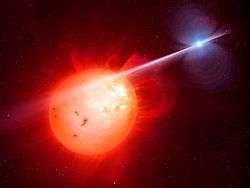2MASS J18082002−5104378
2MASS J18082002−5104378 (abbreviated J1808−5104) is an ultra metal-poor (UMP) binary star system, in the constellation Ara, about 1,950 ly (600 pc)[5][6][7] from Earth, and is a single-lined spectroscopic binary (SB1). It is one of the oldest stars in the universe, about 13.53 billion years old, possibly one of the first stars, a star made almost entirely of materials released from the Big Bang. A tiny unseen companion, a low-mass UMP star, is particularly unusual.
| Observation data Epoch J2000 Equinox J2000 | |
|---|---|
| Constellation | Ara[2] |
| Right ascension | 18h 08m 20.02s |
| Declination | −51° 04′ 37.8″ |
| Apparent magnitude (V) | 11.9[3] |
| Astrometry | |
| Proper motion (μ) | RA: −5.672[4] mas/yr Dec.: −12.643[4] mas/yr |
| Parallax (π) | 1.6775 ± 0.0397[4] mas |
| Distance | 1,950[5][6][7] ly (600 pc) |
| Details | |
| A | |
| Radius | 2.44[4] R☉ |
| Luminosity | 5.311[4] L☉ |
| Surface gravity (log g) | 3.0[3] cgs |
| Temperature | 5,440[3] K |
| Metallicity [Fe/H] | -4.1[3] dex |
| B | |
| Mass | 0.14+0.06 −0.01[1] M☉ |
| Age | 13.535±0.002[1] Gyr |
| Other designations | |
Gaia DR2 6702907209758894848[5] | |
| Database references | |
| SIMBAD | data |
System
J1808−5104 is an ultra metal-poor (UMP) star, one that has a metallicity [Fe/H] less than −4, 1/10,000th of the levels in the sun.[8] It is a single-lined spectroscopic binary, with radial velocity variations in its spectral absorption lines are interpreted as orbital motion of the visible star. The companion is invisible, but inferred from the orbit.[1]
J1808−5104 is the brightest UMP star, as a binary system, known,[8][9] and is part of the "thin disk" of the Milky Way, the part of the galaxy in which the Sun is located, but unusual for such a metal-poor and old star.[10] At 13.53 Gyr, the star is the oldest known thin-disk star, and several billion years older than most estimates for the age of the Milky Way's thin disk.[1]
Primary star
The primary component of the binary star system, 2MASS J18082002−5104378 A, is a subgiant, cooler than the Sun, but larger and more luminous.[3]
Secondary star
The secondary unseen companion, 2MASS J18082002−5104378 B, thought to be a red dwarf,[5] has an orbital period P = 34.757+0.010
−0.010 days and a mass of 0.14 M☉.[1] It is the first low-mass UMP star to be discovered, and one of the oldest stars in the universe, about 13.53 billion years old,[5] possibly one of the very first stars, a star made almost entirely of materials released from the Big Bang.[17]
References
- Schlaufman, Kevin C.; Thompson, Ian B.; Casey, Andrew R. (5 November 2018). "An Ultra Metal-poor Star Near the Hydrogen-burning Limit". The Astrophysical Journal. 867 (2): 98. arXiv:1811.00549. Bibcode:2018ApJ...867...98S. doi:10.3847/1538-4357/aadd97.
- Staff (2018). "Finding the constellation which contains given sky coordinates". DJM.cc. Retrieved 5 November 2018.
- Meléndez, Jorge; Placco, Vinicius M.; Tucci-Maia, Marcelo; Ramírez, Iván; Li, Ting S.; Perez, Gabriel (2016). "2MASS J18082002-5104378: The brightest (V = 11.9) ultra metal-poor star". Astronomy and Astrophysics. 585: L5. arXiv:1601.03462. Bibcode:2016A&A...585L...5M. doi:10.1051/0004-6361/201527456.
- Brown, A. G. A.; et al. (Gaia collaboration) (August 2018). "Gaia Data Release 2: Summary of the contents and survey properties". Astronomy & Astrophysics. 616. A1. arXiv:1804.09365. Bibcode:2018A&A...616A...1G. doi:10.1051/0004-6361/201833051. Gaia DR2 record for this source at VizieR.
- News Staff (6 November 2018). "One of Milky Way's Oldest Stars Discovered". SciNews.com. Retrieved 6 November 2018.
- Crockett, Christopher (12 November 2018). "Puny Star Might Be Specimen from Early Universe". Sky & Telescope. Retrieved 14 November 2018.
- Williams, Matt (9 November 2018). "Ancient Star Found that's Only Slightly Younger than the Universe Itself". Universe Today. Retrieved 14 November 2018.
- Ezzeddine, Rana; Frebel, Anna (2018). "Revisiting the Iron Abundance in the Hyper Iron-poor Star HE 1327−2326 with UV COS/HST Data". The Astrophysical Journal. 863 (2): 168. arXiv:1807.06153. Bibcode:2018ApJ...863..168E. doi:10.3847/1538-4357/aad3cb.
- Ezzeddine, Rana; Frevbel, Anna (27 September 2018). "Revisiting The Iron Abundance In The Hyper Iron-Poor Star HE 1327−2326 With UV COS/HST Data". The Astrophysical Journal. 863 (2): 168. arXiv:1807.06153. Bibcode:2018ApJ...863..168E. doi:10.3847/1538-4357/aad3cb.
- Rosen, Jill (5 November 2018). "Johns Hopkins scientist finds elusive star with origins close to Big Bang - The newly discovered star's composition indicates that, in a cosmic family tree, it could be as little as one generation removed from the Big Bang". Johns Hopkins University. Retrieved 5 November 2018.
- Wehner, Mike (5 November 2018). "Astronomers spot one of the oldest stars ever". BGR. Retrieved 5 November 2018.
- Gemini Observatory (5 November 2018). "A Tiny Old Star Has A Huge Impact". SpaceRef.com. Retrieved 6 November 2018.
- Johns Hopkins University (5 November 2018). "Johns Hopkins scientist finds elusive star with origins close to Big Bang". EurekAlert!. Retrieved 5 November 2018.
- Starr, Michelle (5 November 2018). "Astronomers Have Detected One of The Oldest Stars in The Entire Universe". ScienceAlert.com. Retrieved 5 November 2018.
- Irving, Michael (5 November 2018). "13.5 billion year old star was born just after the Big Bang - and it's in our neighborhood". NewAtlas.com. Retrieved 5 November 2018.
- Malewar, Amit (5 November 2018). "Johns Hopkins scientists may have found one of the universe's oldest stars - One of the universe's oldest stars". TechExplorist.com. Retrieved 5 November 2018.
- [1][11][12][10][13][14][15][16]
